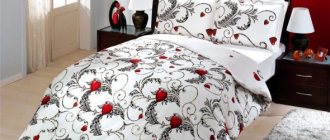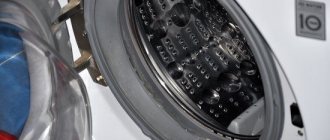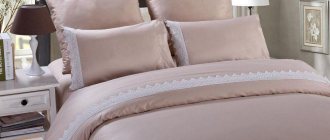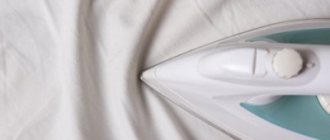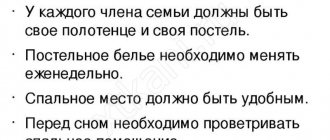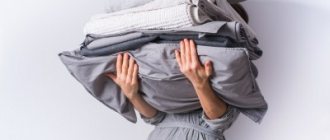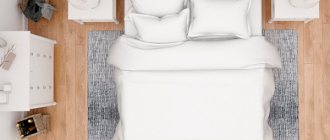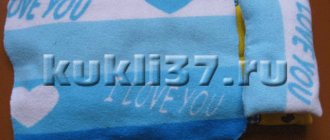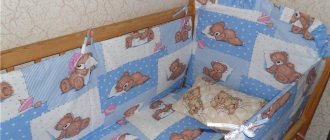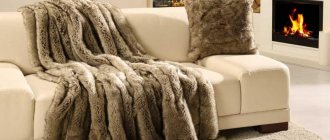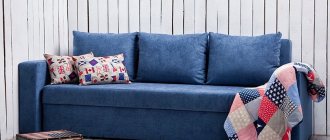The textile industry has stepped far forward, and now housewives no longer have an urgent need to sew things on their own. This makes life much easier, but many craftswomen sometimes want to please themselves and loved ones with a set of sheets made of beautiful fabric, not factory-made, but hand-made. However, they cannot dare to do this. Often it is dissatisfaction with their own skills that prevents them from taking control of the matter, and then people turn to the studio. But today we will try to prove that sewing bed linen on your own is a feasible task, especially if you know how to make the necessary measurements, how much fabric is needed for bed linen, and what sequence of actions must be followed.
Sewing a bedding set from your favorite fabric is easy if you follow the instructions
Fabric calculation
Fabric consumption for a bedding set
Before sewing bed linen with your own hands, it is first of all important to carry out a number of manipulations: the most important thing is to take accurate measurements. They will help you correctly calculate the fabric for individual tailoring.
If you want to make a high-quality set of bed linen, approach the process with all care. Don’t skimp on the quality, and most importantly, the quantity of fabric (it’s better to have an extra scrap left than to collect pieces with scraps).
Layout for cutting a set on fabric 220 cm wide
In stores you often find ready-made sets of canvas with already calculated length and width (for standard sets this is approximately 2 - 2.5 meters). Consider the likelihood of shrinkage (especially after machine washing - about 5%), as well as the features individual to each individual material.
Table for calculating fabric yardage for bedding sets
How to sew a duvet cover
- from the remaining piece of fabric we measure 220 or 230 cm in length and 150 or 160 in width, respectively;
- The seams at the top and bottom need to be sanded down and overlocked;
- on either side, right in the center, leave a hole for a hole (where we will insert the blanket). The optimal option is 40-50cm; the seams on the sides up to the hole need to be overcast and ground down;
- the edges of the hole itself can be trimmed with beautiful braid.
Calculation of fabric for children's bedding
Let us illustrate more clearly with an example of sewing children's bedding. Let's take a mattress 90 cm wide and a pillow measuring 60 cm by 60 cm.
We calculate the canvas.
- 1 sheet - you will need approximately 120cm x 2. If you want to tuck the edges under the mattress, add a little more padding around the edges. The pass is calculated based on the height of the mattress.
- Duvet cover - raw materials are calculated based on the size of the blanket under which it is actually sewn. It turns out: for a 1.2 m blanket you will need - two widths + 10 cm allowance + 10 cm for shrinkage + 10 cm so that the blanket is free = 2 m 70 cm + 10 cm seams.
- 2 pillowcases – their size remains the same as the size of the pillows + 10 cm, leave seams sewn and another + 10 for shrinkage. Cut the pillowcase along the material to make the process more economical.
By summing up all the necessary measurements, we will get the exact amount of fabric that will be needed in the process of sewing a bedroom set. It’s better to protect yourself - buy with a reserve in order to avoid troubles later.
Elements of children's bedding - cut to a fabric width of 150 cm
How to sew a sheet
The first and easiest thing is, of course, sewing the sheets:
- cut 110 cm of material from the entire piece of fabric (if it’s for a baby’s crib).
- the width remains respectively 140 cm;
- we literally hem 1 cm of the edge around the entire perimeter. The sheet is ready!
Another option for the second set is a sheet with an elastic band - an ideal option for a baby’s crib:
- cut a rectangular piece of fabric measuring 120 by 150 cm;
- fold it four times and in the corner on the top right with scissors we cut out a square with sides of 20 cm;
- Next you need to stitch the corners and process them with an overlocker;
- the edges of the future sheet need to be folded and also stitched, while leaving space for elastic on four sides;
- We insert the elastic into the finished sheet and stretch it along the entire perimeter, sewing the edges tightly.
How much fabric do you need to sew a double bedding set?
To sew a standard double set, you will need:
- for duvet cover – 200/200; 180/210; 180/210;
- sheets – 175/210; 200/220; 210/230;
- sewing pillowcases – 50/50; 60/60; 50/70.
Let's calculate the amount of fabric needed.
To sew a duvet cover measuring 180 by 180, fold a piece of fabric in half + 5 cm allowance = 365 cm.
Cutting sheet 200 cm + 5 = 205 cm.
For pillowcases – 125 cm.
In total, you need 6m 95 cm to make the entire set.
Layout of the cut with seam allowances and fabric shrinkage for a double set
How to make bumpers for a baby crib
But recently, almost all parents are equipping their crib with safety features called bumpers. Their direct purpose is to protect the baby in the crib from bruises that may occur when hitting the crib bars.
You can very easily sew bumpers for a baby crib with your own hands:
- the fabric for the sides should be much denser than for the other elements of the set;
- We make patterns for the sides with our own hands. They should be rectangular in shape, 60 by 40 cm in width and 120 by 40 in length.
- as a result, you should get two small sides and 2 long ones;
- we sew the future product on the sides, like a pillow, having first placed a strong braid or ribbon in the corners, which will be used to tie the side to the crib;
- The finished side needs to be turned right side out, and foam rubber pre-prepared to size should be placed inside; Next, we sew in the lock - the side is ready!
All that remains is to put the bedding in the crib, and the job is done!
How much fabric do you need for a Euro bedding set?
For a luxury set you will need approximately:
- duvet cover - 220/240; 215/225; 200/220;
- sheet – 220 x 240; 220 x 250; 215 x 240;
- pillowcases – 50 x 50; 50 x 70; 60 x 60.
We calculate the amount of production fabric.
Duvet cover – bend the fabric so that both pieces are 240 + 5 cm each.
Sheet – 245.
Pillowcases – 115.
In total, it turns out that to make a euro headset it will cost 8 m 45 cm of good quality fabric.
Layout of the cut with seam allowances and fabric shrinkage for the euro set
Several recommendations for choosing material
Bed fabric with a cherry blossom pattern
Sewing a sleeping set with your own hands gives you the opportunity to choose any fabric you want (even the cheapest - as long as you like it). However, it is important to remember that these pillowcases and sheets are for the purpose of sleeping on them; imagine what a dubious pleasure it is to “sleep on kitchen towels.”
Basic requirements for fabric.
- Softness, pleasantness, comfort - it simply needs to be suitable for sleep, as well as accompany its normal course.
- Natural - synthetic - the worst thing you can choose for sewing bed linen. Give preference to breathable, natural materials (silk, calico, cotton) that will retain heat in winter and provide normal ventilation in summer.
Natural fabric for a bedding set is the key to a sound, healthy sleep. They will not harm children's health; easy to handle; affordable.
Color spectrum
Another important criterion that parents don’t think much about is the shade of the laundry. Carefully measuring the child’s height and the dimensions of the mattress, they manage to focus on safety and comfort, completely losing sight of the colors. Psychologists say that with the help of the right color scheme, you can grow a talented, self-confident person, and sometimes even cure mental illness. The effect of color on a child's body is indicated in the table below.
Table - Primary colors and their effect on the child’s body
| Bed color | Impact on the psyche |
| Green | - Helps relax; - promotes calmness |
| Red | - Causes aggression; - capable of oppressing |
| Yellow | — Improves mood; - causes joy; – provokes anxiety (if abused) |
| Blue | — Normalizes sleep; - promotes relaxation; - provides calming to the nervous system |
| Blue | — Eliminates tension (only as small accents); — helps to fall asleep (if the shade is not dominant); - depresses the nervous system (if blue is the main color) |
| White, beige | — Calms the nervous system; - ensures restful sleep; - leads to melancholy if not diluted with bright colors |
| Grey | — Promotes self-confidence (only small accents) |
| Brown | - Causes boredom; - can provoke apathy |
| Black | — Causes destruction of the child’s psyche (in large quantities); - neutral if used as outlines of a picture or small print |
Threads for bed linen
Modern manufacturers offer a large selection of durable, reliable and good threads
They are also recommended to be given due attention. Correctly selected thread strength, thickness, density, and their color matching to the selected material will ensure the quality of your finished work.
The market offers a wide range of different threads: from ordinary cotton to silk or even the finest gold. For sewing, the following will be the best.
- Polyester threads "Durafix".
DURAFIX sewing threads made in Turkey - Professional threads made of high-strength polystrong.
- Capitone threads - suitable for all occasions; weightless but durable, they perfectly hold even dense samples together.
Threads are often marked with the following marks: LH - linen cotton; LL – flax lavsan. The numerical designation indicates the thickness of the thread.
Threads made from synthetic materials (for example, 100% polyester) have much higher parameters than natural products. They are much stronger, less likely to delaminate, and the tension coefficient is also much higher. A high-quality thread is easy to recognize by eye: its structure is even and smooth. The stitching with these threads is neat and smooth.
Patterns for sewing sleeping linen with your own hands
We cut the sheet to cover the entire width of the fabric, and calculate the length using the formula: length of the mattress + 20 cm
We make the length of the duvet cover to cover the entire width of the fabric, and calculate the width of the duvet cover using the formula: the width of your blanket + 6 cm (shrinkage allowance) + 1.5 cm (seam allowance) x 2
Cutting is the second, but not the most important, stage, the stage after taking measurements and establishing the required size of the canvas. Here you are required to apply maximum care, since it is very important not to cut off too much, otherwise it will no longer be possible to correct it. Next, we will give some tips to optimize the sewing process as much as possible and avoid damage to expensive brocade through your own efforts.
A piece of fabric for pillowcases 50 by 70 cm = (50 cm x 2 + 25 cm (at the hem) + 5 cm (seam allowances))
Piece for pillowcases 70 by 70 cm = (70 cm (side) x 2 + 25 cm (at the hem) + 5 cm (seam allowances))
How to sew a pillowcase
The most difficult thing here is to carefully and accurately fold the pattern.
- measure approximately 70 cm of fabric and fold it with the outer side inward;
- a 30 cm corner remains, we wrap it towards the top (this will be a pocket that holds the pillow in the pillowcase;
- fold the edges evenly on the sides twice and stitch;
- The pillowcase remains to be turned right side out.
How to approach the process correctly?
- Before you start cutting, iron the fabric thoroughly (preferably with steaming). This way you can smooth out unnecessary wrinkles, unevenness, and perform initial shrinkage - believe me: this will make the process much easier.
- We mark the necessary notes. It is best to use chalk or a flat piece of white soap (soap). If you don’t have them, aspirin tablets will come in handy. It also distinguishes perfectly and washes without problems.
- To avoid inaccuracies, it is important to duplicate each mark on both edges.
Let's sum it up
This floral set seems too simple, but made with love by your own hands, it will delight you every day
If you resort to sewing a sleeping set yourself, then nothing can limit your creativity, inspired by a flight of fantasy and creativity. The main thing is not to forget about the practical side of the future product, because this underwear should constantly please the eye, but also “calm” the body and give rest during sleep. Choose the material wisely, follow the instructions and you will certainly succeed!
Required tools and materials
Before you start sewing anything, including bedding, you need to make sure that you have everything you need for this work.
In addition to the purchased piece of fabric, you will need:
- sewing machine with needles for sewing various fabrics;
- overlock;
- cutting table (you can use a clean floor, but this is not so convenient);
- scissors;
- measuring tape;
- ruler;
- sewing needles;
- threads in spools of appropriate colors;
- threads in spools or bobbins are bright (for basting);
- seam ripper;
- pincushion;
- pins;
- thimble;
- chalk or piece of soap (for markings);
- snake - lightning (if necessary).
The list is not exhaustive and other adaptations may be required.
